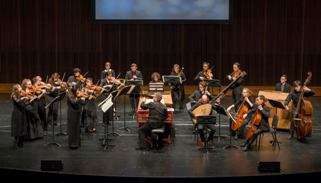|
Back
Juilliard Ensemble Pays Worthy Anniversary Tribute to Handel (et al) New York
Peter Jay Sharp Theater
10/12/2019 -
Charles Avison: Concerti grossi No. 1 in A Major & No. 3 in D minor (after sonatas by Domenico Scarlatti)
George Frideric Handel: Concerti grossi in B-flat Major, Op. 3, No. 2, in G Major, Op. 3, No. 3, in G Major, Op. 6, No. 1, & in A minor, Op. 6, No. 4 – Organ Concerto in F Major, Op. 4, No. 5
Taya König-Tarasevich (flute), Jacob Dassa (organ)
Juilliard415, Richard Egarr (harpsichord and director)

(© Richard Termine)
Friday night’s concert marked the beginning of the tenth-anniversary season of Juilliard415, the school’s flagship period-instrument ensemble, on this occasion led from the harpsichord by the distinguished Baroque specialist Richard Egarr in a well-chosen program dominated by Handel. That composer’s Op. 6 Concerti Grossi do not belong to his handful of truly ubiquitous works, but they represent by any measure one of the highest peaks of baroque instrumental music. Handel sought in these works to pay tribute to his mentor Arcangelo Corelli’s, whose own Op. 6 set the standard for this genre–yet Handel generally surpasses his model in dramatic variety and melodic inspiration. If this melodic inspiration is perhaps slightly less pronounced in Handel’s own earlier Op. 3, the discrepancy is not great, and it was a pleasure to hear the Juilliard players give us two from each opus: the Second and Third Concertos from Op. 3 and the First and Fourth from Op. 6. Of these four pieces, Op. 6, No. 1 perhaps finds Handel’s melodic inspiration at its very freshest–which is saying something—but all are brimming with contrapuntal interest, drama, and life.
Beyond these concerti grossi, Handel was represented by the Organ Concerto in F major. Egarr’s opening remarks had stressed the operatic character of much of the composer’s instrumental music, and it was in the intricate yet effervescent lyricism of this work that this was most evident. The program also included two further concerti grossi, this time by the British composer Charles Avison. These are in fact suites consisting of orchestrated movements from keyboard sonatas by Scarlatti. There was a good deal to enjoy here as well, even if the transcription for strings inevitably dampens some of the sparkle and scampering mischief of Scarlatti’s keyboard originals, even when realized on the piano (as done memorably by Horowitz). But it would be churlish to complain too much–in themselves, Avison’s confections were perfectly satisfying.
What of the performances? The ensemble responded to Egarr’s direction with not only vigor and cohesion but also expressive refinement; I was especially impressed by the consistently natural yet imaginative approach to dynamic contrasts. I must admit that I typically find the distinctive tonal characteristics of gut strings played in full period style to be more effective in one-to-a-part chamber music than in an orchestral setting (indeed, I would suggest that in the right hands, modern string-playing can bring a greater sense of linear clarity to the Baroque orchestral repertoire). It is perhaps owing to this that I often found the concertante solos especially affecting. Here I would single out for special praise Matthew Hudgens’ plaintive oboe solo in the lovely Largo of Handel’s Op. 3, No. 2, as well as the playing of the alternating concertmasters (Chloe Kim in the first half and Shelby Yamin in the second). But everything was really at a very high standard: delightful repertoire buoyantly realized.
Samuel Wigutow
|